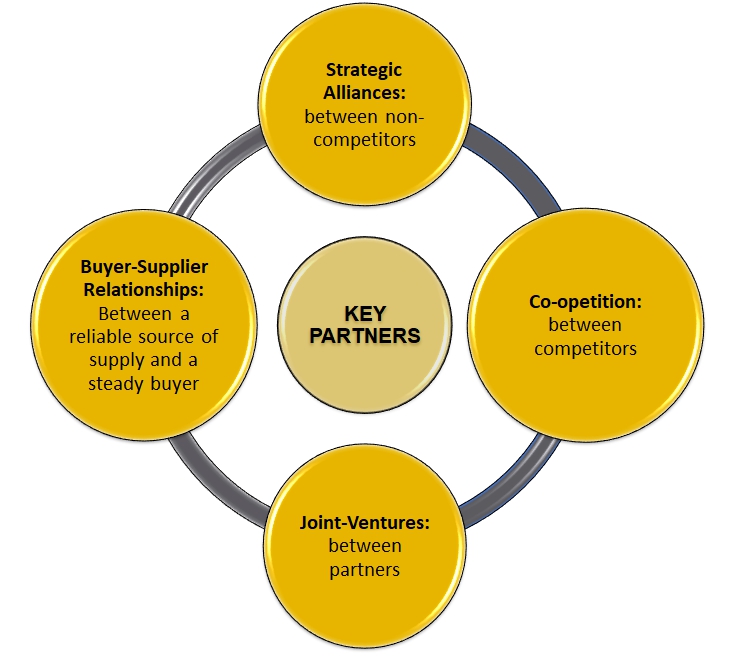Module 9
KEY PARTNERS
The purpose of the Key Partners module is to support managers and entrepreneurs to identify strategic partners for the correct functioning of the business and to foster the creation of joint collaboration.



Key partners
Introduction
Any company needs a partner strategy to be successful in business. Key Partners are all external people and companies which an enterprise works with to ensure that the business model succeeds.
Purpose
The purpose of the Key Partners module is to support managers and entrepreneurs to identify strategic partners for the correct functioning of the business and to foster the creation of joint collaboration.
Learning Outcomes
After the completion of this module the learner will be able to:
-
- define the concept of key partners
- list the main partnership agreements with respective advantages and disadvantages
- identify key partners to support their own company/enterprise operations
- illustrate the importance of key partners to satisfy customer needs
- explain the relationship between partners to create joint value
- analyse the role of key partners
- choose the most suitable partner(s) to reduce their own inefficiencies
- set conditions for an agreement from which the company would benefit
Keywords
-
- companies/enterprises
- partners
- partnerships
- cooperation
- suppliers
- competitors
- alliance
- trust
- joint value
- commitment
Theoretical background

BUILDING STRATEGIC PARTNERSHIPS
The role of communication
A business partnership entails an alliance stipulated by two parties, generally joined together by means of a contract or an agreement. In some cases agreements are loose relationships where parties are quite independent of each other, while other agreements are more exclusive, and dictate a set of specific obligations which partners are subject to adhere to.
The key factor for choosing the most suitable partner is communication. Partners should coordinate themselves and work in the same way.
A partner should complement your skills and be a trustful person, underestimating how you relate to and get along with your partner is a terrible mistake.
Key elements in partnership
There are some main elements to consider when setting up partnerships:
-
- Clear Partnership Agreements: It is important to set clear partnership agreements for the parties involved. The activities and roles of partners should be regulated.
- Set Expectations: When defining an agreement, entrepreneurs should make sure to share their own expectations freely and openly, this will help avoid confusion and complaints later on.
- Win-Win situation: Partnerships are healthy and sustainable only if there is visible gain for both parties, therefore, when forming a partnership you have to make sure that your partner’s key resources and activities fill your gaps.
- Selecting Partnerships: Some partnerships may seem lucrative in theory but fail to get off the ground practically. In addition, changes in the business context may also make some business partnerships irrelevant. In such cases, it is important to end these partnerships quickly to avoid further wastage of resources.
Benefits of partnership
There are many reasons for setting key partnerships. Companies can:
-
- optimize their own resource utilization,
- fill gaps in their own activities,
- create new products,
- mitigate the degree of risk taken by setting alliances with strong partners before taking the action,
- share the same distribution channels.
It is important to consider that your organization could partner with a set of partners, however, not all partner relationships are pivotal for your activity.
Bear in mind that partnerships change across the whole lifecycle of companies. Some types of partnerships may be necessary during the first year of activity of a start-up, but they may change within the first three years.
Key questions for an effective partnership
When setting up / assessing a partnership in a company/ enterprise, the following questions may be helpful:
-
- What partnerships may be strategic to my business?
- Who are our critical suppliers?
- Which of our suppliers and partners are sourcing our key resources?
- What type of partnerships would best suit our needs?
- What is the best cluster/ supply chain where I should be located?
DIFFERENT TYPES OF STRATEGIC PARTNERSHIPS
Partners and partnerships can be classified into four groups:
-
- Strategic Alliances: These alliances take place between non-competitors. E.g., online news agencies and offline news agencies.
- Co-opetition: This involves co-operation between competitors. These partnerships allow partners to mitigate and reach a more convenient distribution of risk. They may help partners and competitors to be aligned in order to create a new product
- Joint-Ventures: These partnerships are stipulated by partners with a mutual interest, for example, facing an emergency situation, creating a new business in a new market or in a new geographical area. A joint-venture agreement functions only if both organizations supply an input. For example, a company specialized in producing cheese may choose to run a new business with a package food supplier, entering a new market, e.g., Cheesy pasta.
- Buyer-Supplier Relationships: These relationships are the most common. They ensure a reliable source of supplies coming in. For suppliers this means that there is a steady confirmed buyer for their product.
Examples of Partnerships: Strategic Alliances
| The agreement between Starbucks and Barnes & Noble is one example of a strategic alliance: Starbucks brew the coffee, Barnes & Noble supply the books. The two companies share the costs of space to the benefit of both of them.
For a better understanding of this topic, watch the video: ‘Advantages Of Strategic Alliances And Joint Ventures [2 Critical Things For Success]’ |
 |
Strategic Alliances
Advantages
-
- A strategic alliance agreement could help a company develop a more effective process.
- Strategic alliances allow two organizations, individuals or other entities to work towards common or correlating goals and to achieve more organic growth, which would be realized over a longer period of time if each of them worked alone.
- Strategic alliances can be flexible, the two firms do not need to merge capital and can remain independent of one another.
- Strategic alliances can be stipulated by companies of different sizes and types.
Disadvantages
-
- There may be differences in how the companies conduct business and create conflicts if communicative skills and trust among allies are underestimated.
- With long-term strategic alliances, one partner may become dependent on the other, undermining the health of the partnership.
STRATEGIC PARTNERSHIPS
Examples of Partnerships: Co-opetition
| An example of co-opetition is the case of Samsung which supplies components to produce the Apple iPhone. Both firms are, however, top sellers in the smartphone market. The primary scope of the co-opetition is to increase technology diversity and new product development. |  |
Advantages of co-opetition
-
- Co-opetition supports companies when facing new challenges dictated by markets, as a consequence, in some cases it may be the most practical solution.
- It allows companies to obtain non-tangible resources.
- Synergy affects complementary resources, making them more valuable and difficult to imitate.
- Co-opetition stimulates differentiation and development of new resources. As a result it supports companies to focus on innovation, as they increase cooperation and communicative skills as people are encouraged to transfer their knowledge. Competitive cooperation allows companies to achieve economies of scale and reduce operational costs.
Disadvantages of co-opetition
-
- There is a real risk of losing control over a company’s own resources due to common technologies or potential cyber compromises such as espionage or hacktivism.
- Co-opetition may lead to an asymmetry of benefits derived from the relationship and distort the grounds for stable cooperation.
- The coexistence and interaction of streams of cooperation and competition in the relationship between the parties may reduce the effectiveness of the cooperation, if the common goals and objectives of partners do not match. Within this scenario it is likely that the common goals and the relationship among the allies set in advance start to falter.
- Sometimes contractual clauses include some decision-making liberty contractual limits, such as not allowing companies to establish other partnerships, which leads to a disadvantage when creating multiple cooperative links. There is a concrete danger of transforming the relationships into a zero-sum game, resulting in a loss of trust and deterioration of the relationship.
- Co-opetition disadvantages may be linked to the image of the company, particularly if one company exhibits inefficiencies in customer care or assistance services.
Examples of Partnerships: Joint Venture
A joint venture is an agreement between businesses which adopt a form of collaborative work to reach a shared strategic target or goal. The companies remain separate in legal terms. It is usually adopted for commercial purposes, such as the launch of a new product or to enter into a new market.
| Google Earth is an example of joint venture between Google and NASA.
“Google and NASA share a common desire — to bring a universe of information to people around the world” – Eric Schmidt, Google chief executive officer. |
 |
Joint Ventures
Advantages
-
- New product development by sharing of knowledge and expertise;
- Expanding into new markets;
- Mutual strengthening of their own performance by leveling strengths and weaknesses;
- Shared costs, marketing and co-sponsoring events;
- Temporary partnership limited in time and linked to the development of a specific product/service;
- Shared goals and risks.
Disadvantages
-
- Difficulties in the decision making process
- Lack of commitment may create imbalances
Examples of Partnerships: Buyer-supplier relationship
Buyer Supplier Relationship is a type of partnership which involves the supply chain. Since the customer and supplier are interdependent, it consists of the creation of a long-lasting relationship in which the supplier gains a preferred status within the chain by meeting the customers’ needs. However, this business relationship may vary in terms of involvement and continuity.
| For example, Ford Motor Company is an American multinational automaker. The company set up the ABF network, a network including a list of preferred partners and suppliers, consisting of 67 production and 23 non-production suppliers from around the world. |  |
Buyer-supplier relationships
Advantages
-
- Short-term or long-term relationships depending on the agreement;
- Trust building by consolidating the supply chain, greater commitment and reliability;
- Opportunities for price discounting and special deals;
- Flexibility in the timing of payments;
- Sharing of information, forecasts, knowledge and customers between the buyer and the supplier.
Disadvantages
-
- High level of commitment and work to maintain in order to establish the relationship;
- Accurate forecasts about the future performance and needs of both businesses;
- Selection of the right partner due to associated risks and potential problems;
- Meeting your requirements as a partner.
Examples and Good practice
| Examples:
Strategic Alliances: Starbucks and Barnes & Noble: They share the costs of space. Co-opetition: Samsung and Apple: They seek technology diversity to develop new products. Joint-Ventures: Google and NASA: They collaborate to reach a shared strategic goal. Buyer- Supplier Relationships: Ford Motor Company and the ABF network: Interdependence of the supply chain according to the customer’s needs. |
 |
References and External Links
-
- https://www.investopedia.com/terms/s/strategicalliance.asp#:~:text=The%20deal%20between%20Starbucks%20and,the%20benefit%20of%20both%20companies/
[consulted 21/07/2020] - https://www.business2community.com/strategy/key-partners-and-your-business-model-02278564
[consulted 21/07/2020] - http://www.ecommerce-digest.com/key-partnerships.html
[consulted 21/07/2020] - https://businessmodelanalyst.com/key-partners-business-model-canvas/
[consulted 17/07/2020] - http://www.leansolutions.it/management/modelli-di-business/business-model-canvas-key-partnership
[consulted 17/07/2020] - https://strategyzer.uservoice.com/knowledgebase/articles/1194355-how-do-i-use-the-key-partnerships-building-block-o
[consulted 21/07/2020]
- https://www.investopedia.com/terms/s/strategicalliance.asp#:~:text=The%20deal%20between%20Starbucks%20and,the%20benefit%20of%20both%20companies/
Copyright @2021 – businessmodels.eu

